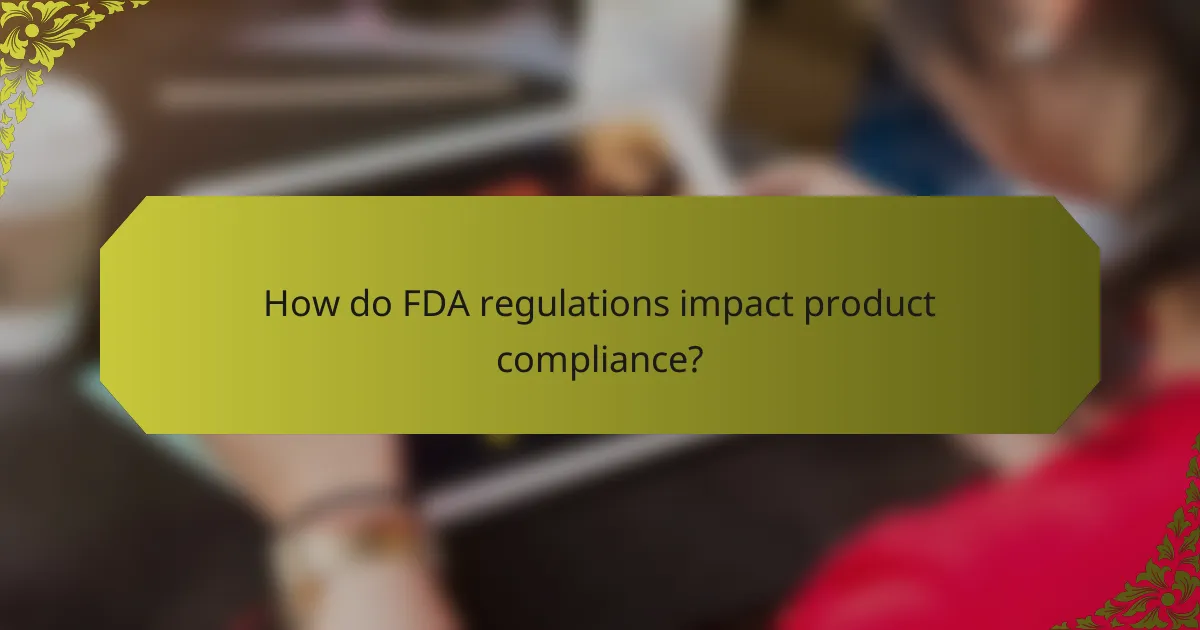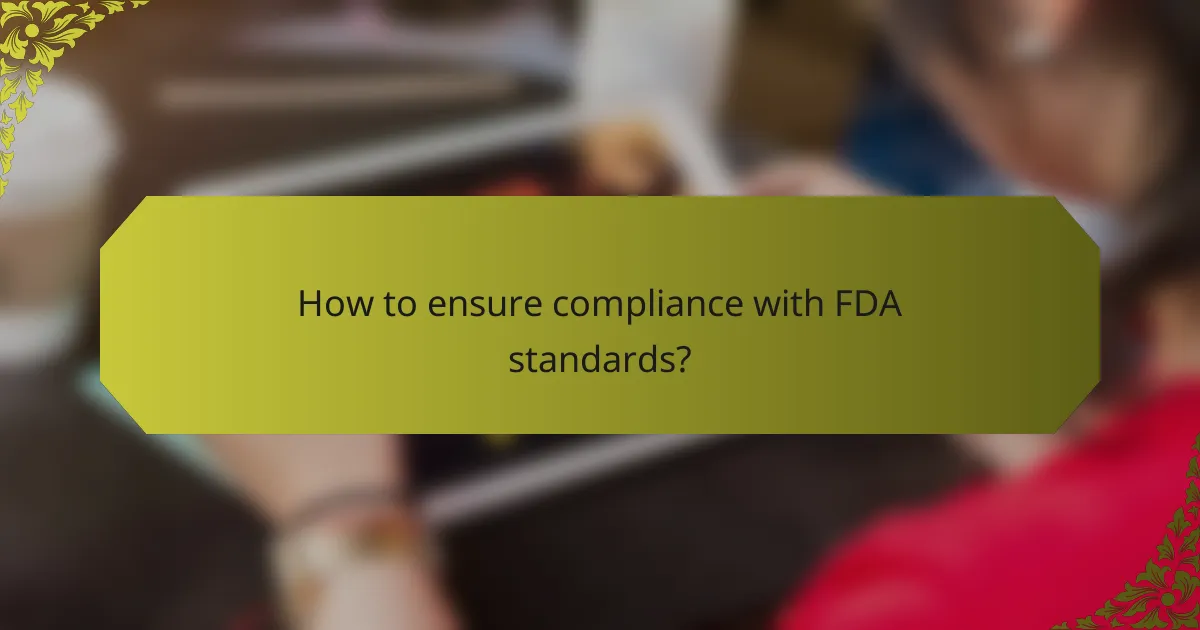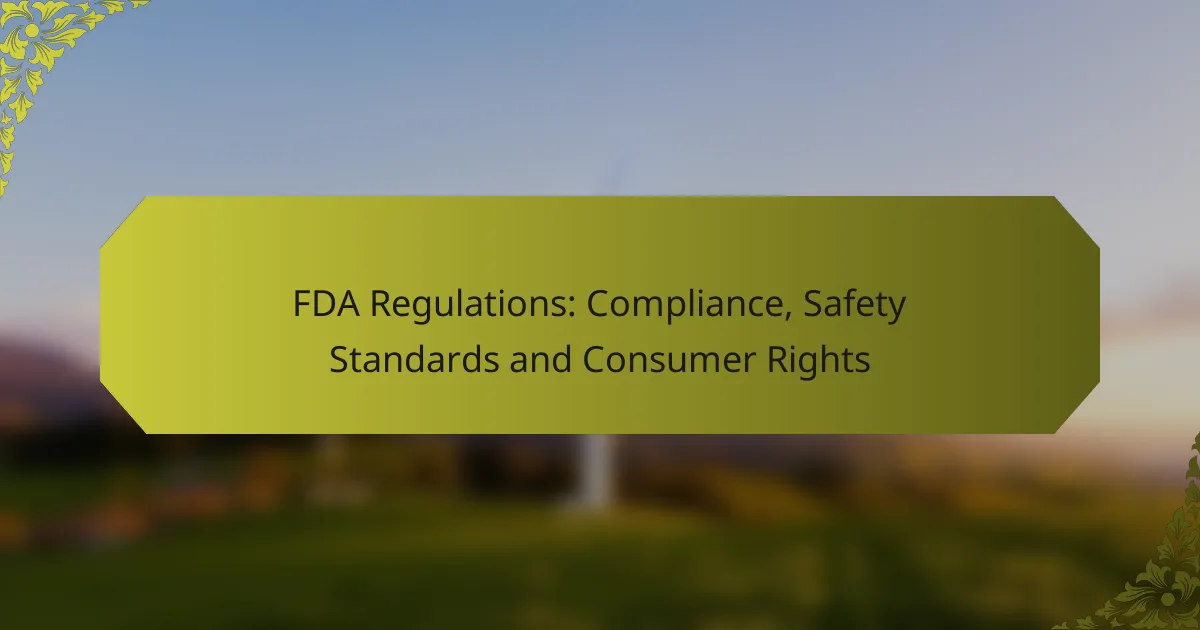The FDA regulations play a crucial role in safeguarding public health by setting forth laws and guidelines that ensure the safety and efficacy of food, drugs, and medical devices. Compliance with these regulations is mandatory for manufacturers and distributors, who must adhere to established safety standards and labeling requirements. Additionally, consumers are granted specific rights that empower them to make informed choices and voice any safety concerns regarding regulated products.

What are the FDA regulations for consumer safety?
The FDA regulations for consumer safety encompass a range of laws and guidelines designed to protect public health by ensuring the safety and efficacy of food, drugs, and medical devices. These regulations require compliance from manufacturers and distributors to maintain high safety standards and safeguard consumer rights.
Food Safety Modernization Act
The Food Safety Modernization Act (FSMA) focuses on preventing foodborne illnesses by shifting the emphasis from responding to contamination to preventing it. Under FSMA, food facilities must implement preventive controls and conduct risk assessments to identify potential hazards.
Key provisions include mandatory inspections, enhanced record-keeping, and the ability for the FDA to impose recalls. Compliance is essential for food manufacturers and importers to avoid penalties and ensure consumer safety.
Drug Approval Process
The drug approval process involves several stages to ensure that medications are safe and effective before they reach consumers. This includes preclinical testing, clinical trials, and a comprehensive review by the FDA.
Typically, the process can take several years, with costs often reaching millions of dollars. Pharmaceutical companies must provide extensive data on a drug’s safety, efficacy, and manufacturing quality to gain FDA approval.
Medical Device Regulations
Medical device regulations are designed to ensure that devices are safe and effective for public use. The FDA categorizes devices into three classes based on risk, with Class I being the lowest risk and Class III the highest.
Manufacturers must follow specific guidelines for design, testing, and post-market surveillance. Compliance with these regulations is crucial for companies to market their devices and protect consumer health.

How do FDA regulations impact product compliance?
FDA regulations significantly influence product compliance by establishing safety standards and labeling requirements that manufacturers must follow. These regulations ensure that products are safe for consumer use and accurately represented in their marketing.
Labeling Requirements
Labeling requirements set by the FDA mandate that products must include specific information to inform consumers about their contents and usage. This includes ingredient lists, nutritional information, and any health claims made by the manufacturer.
For example, food products must display the Nutrition Facts label, which provides details on serving sizes, calories, and nutrient content. Failure to comply with these labeling standards can result in penalties or product recalls.
Good Manufacturing Practices
Good Manufacturing Practices (GMP) are regulations that ensure products are consistently produced and controlled according to quality standards. These practices cover all aspects of production, from raw materials to the manufacturing environment.
Manufacturers must implement quality control measures, conduct regular inspections, and maintain proper documentation. Adhering to GMP helps minimize risks and ensures that products are safe for consumers.
Post-Market Surveillance
Post-market surveillance involves monitoring products after they have been released to the market to ensure ongoing safety and compliance. The FDA requires manufacturers to report any adverse events or product defects that arise once the product is in consumer hands.
This surveillance can include consumer feedback, product testing, and inspections. Companies should have a system in place for tracking and addressing any issues that may affect product safety or compliance, as this can help prevent larger problems down the line.

What are the consumer rights under FDA regulations?
Under FDA regulations, consumers have specific rights that ensure their safety and access to information about products. These rights empower individuals to make informed choices and report any safety concerns regarding food, drugs, and other regulated items.
Right to Safe Products
Consumers have the right to expect that products regulated by the FDA are safe for use. This means that food, pharmaceuticals, and medical devices must meet safety standards before they can be sold to the public. For example, medications must undergo rigorous testing to demonstrate their safety and efficacy.
If a product is found to be unsafe after it has been released, the FDA has the authority to issue recalls or warnings to protect consumers. It is crucial for consumers to stay informed about any safety alerts related to products they use.
Right to Information
Consumers are entitled to clear and accurate information about the products they purchase. This includes ingredient lists, nutritional information, and potential side effects. Labels must be easy to read and provide essential details that help consumers make informed decisions.
For instance, food products must display nutritional facts that outline calories, fats, sugars, and other components. Understanding this information is vital for individuals managing dietary restrictions or health conditions.
Right to Report Issues
Consumers have the right to report any problems or adverse effects they experience with FDA-regulated products. This reporting can help the FDA monitor product safety and take necessary actions to protect public health. Individuals can report issues through the FDA’s MedWatch program or other designated channels.
It is important for consumers to document their experiences and provide as much detail as possible when reporting issues. This feedback can lead to investigations and improvements in product safety standards.

How to ensure compliance with FDA standards?
Ensuring compliance with FDA standards involves understanding regulations, conducting regular assessments, and implementing effective training. This proactive approach helps organizations maintain safety and quality in their products while protecting consumer rights.
Conduct Regular Audits
Regular audits are essential for verifying compliance with FDA standards. These audits should assess processes, documentation, and product quality to identify any gaps or areas for improvement. Aim to conduct these audits at least annually, or more frequently if significant changes occur in operations.
During audits, focus on key areas such as manufacturing practices, labeling accuracy, and record-keeping. Utilize checklists to ensure all relevant aspects are covered, which can streamline the audit process and enhance accountability.
Implement Training Programs
Training programs are crucial for ensuring that employees understand FDA regulations and compliance requirements. Develop comprehensive training that covers topics such as Good Manufacturing Practices (GMP), quality control, and safety protocols. Regular refresher courses can help reinforce this knowledge.
Consider tailoring training sessions to specific roles within the organization. For instance, production staff may need different training compared to quality assurance teams. This targeted approach can improve retention and application of compliance standards in daily operations.
Utilize Compliance Software
Compliance software can streamline the process of maintaining FDA standards by automating documentation and tracking compliance activities. These tools can help manage records, schedule audits, and monitor training progress, making it easier to stay organized and compliant.
When selecting compliance software, look for features that align with your specific needs, such as user-friendly interfaces, customizable reporting, and integration capabilities with existing systems. This investment can save time and reduce the risk of non-compliance significantly.

What are the consequences of non-compliance?
Non-compliance with FDA regulations can lead to serious repercussions for businesses, including financial penalties, product recalls, and potential legal action. These consequences not only affect the company’s bottom line but can also damage its reputation and consumer trust.
Fines and Penalties
The FDA imposes fines and penalties on companies that fail to comply with regulations. These financial repercussions can range from thousands to millions of dollars, depending on the severity of the violation. Companies may also face additional costs related to compliance efforts after being penalized.
For instance, a company found guilty of mislabeling a product may incur fines that escalate with repeated offenses. It is crucial for businesses to maintain accurate records and adhere to labeling standards to avoid such penalties.
Product Recalls
Non-compliance can lead to mandatory product recalls, which occur when a product is found to be unsafe or not in compliance with FDA standards. Recalls can be costly, involving logistics, disposal, and public relations efforts to manage consumer concerns.
For example, if a food product is contaminated, the company must not only remove it from shelves but also inform consumers and possibly offer refunds. This process can significantly impact sales and brand loyalty.
Legal Action
Legal action is another serious consequence of non-compliance with FDA regulations. Companies may face lawsuits from consumers, competitors, or even the government, leading to costly legal fees and settlements. In some cases, executives may face personal liability.
To mitigate the risk of legal issues, businesses should implement robust compliance programs and conduct regular audits. This proactive approach can help identify potential violations before they escalate into legal challenges.

How do FDA regulations differ across industries?
FDA regulations vary significantly across industries, reflecting the unique safety and compliance needs of each sector. For example, the standards for pharmaceuticals are more stringent than those for food products, emphasizing the different levels of risk associated with each industry.
Food Industry Regulations
The food industry is governed by regulations that ensure the safety, quality, and labeling of food products. The FDA oversees these regulations, which include guidelines for food processing, handling, and distribution to prevent contamination and ensure consumer safety.
Key regulations include the Food Safety Modernization Act (FSMA), which emphasizes preventive measures in food production. Companies must implement Hazard Analysis and Critical Control Points (HACCP) plans to identify and mitigate potential hazards in their processes.
Food manufacturers should regularly review their compliance with labeling laws, which require accurate ingredient lists and nutritional information. Common pitfalls include misleading claims or improper allergen labeling, which can lead to significant legal repercussions and consumer distrust.


